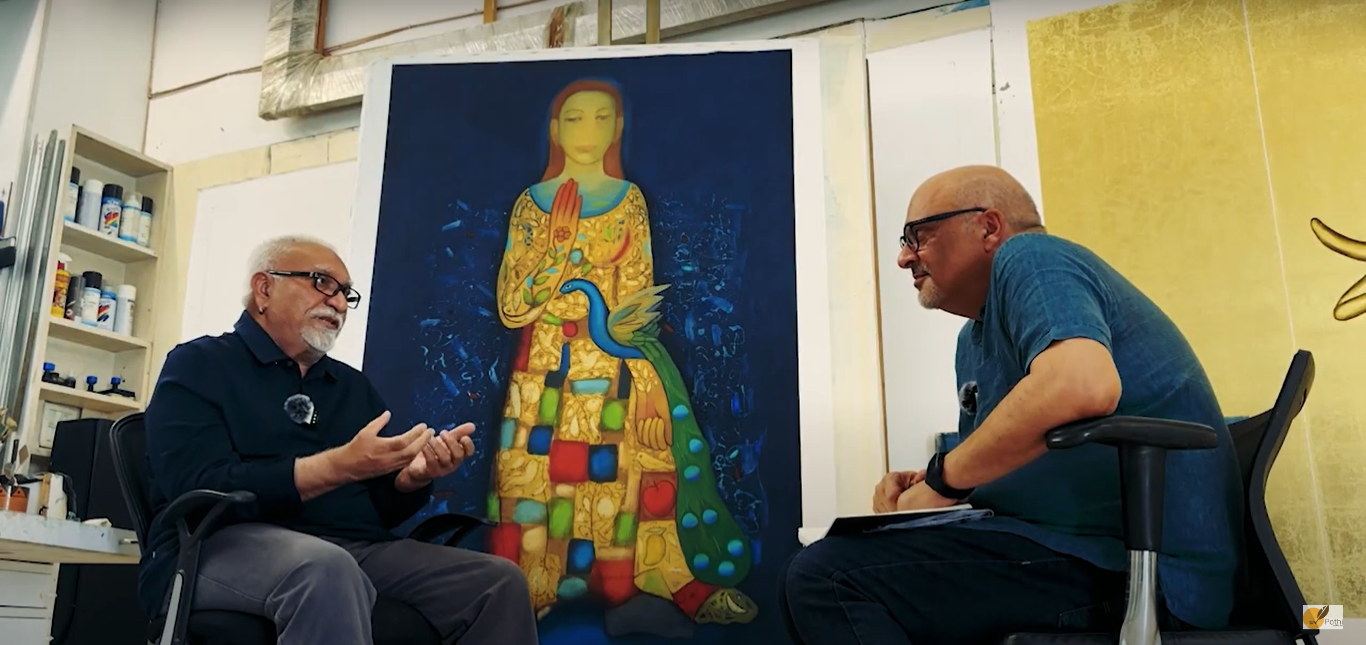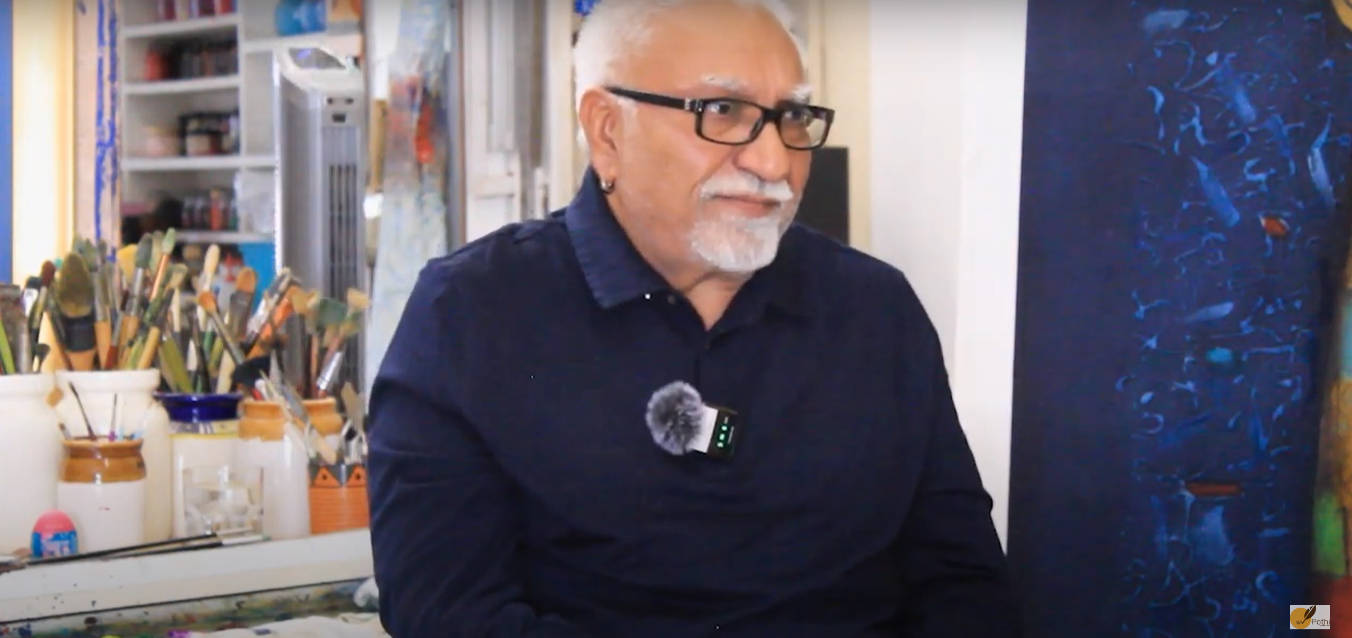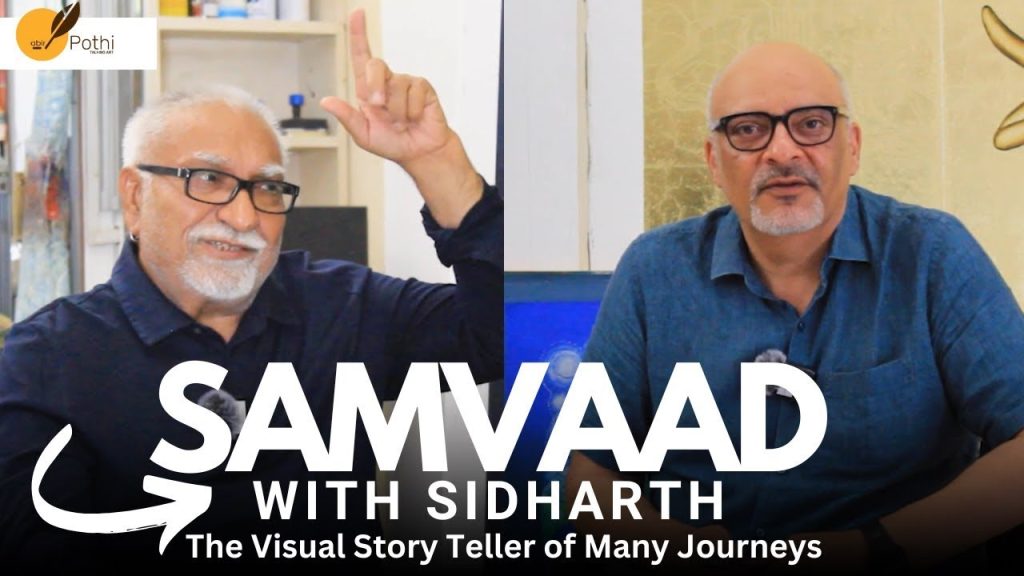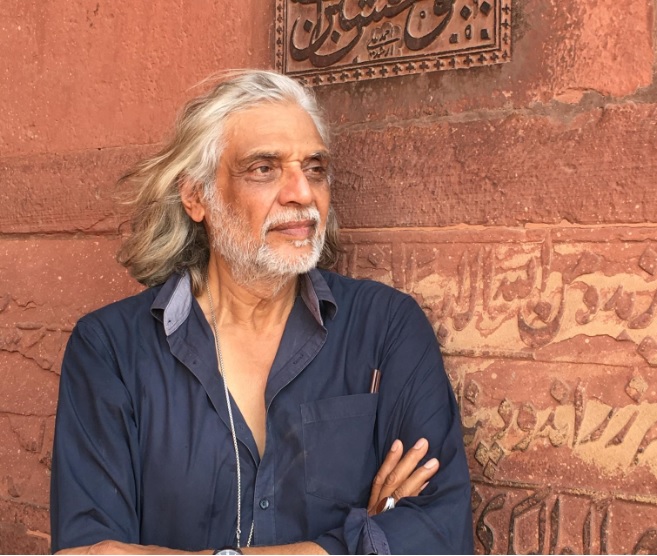Welcome to Samvaad, where art meets conversation, and inspiration knows no bounds. Here we engage in insightful conversations with eminent personalities from the art fraternity. Through Samvaad, Abir Pothi aims to create a platform for thought-provoking discussions, providing readers with an exclusive glimpse into the creative processes, inspirations, and experiences of these creative individuals. From curating groundbreaking exhibitions to pushing the boundaries of artistic expression, our interviews shed light on the diverse perspectives and contributions of these art luminaries. Samvaad is your ticket to connect with the visionaries who breathe life into the art world, offering unique insights and behind-the-scenes glimpses into their fascinating journeys
This is Part I of Samvaad between Nidheesh Tyagi from Abir and Sidharth. While still at school in his village Sidharth started painting signboards. Working as an apprentice with village mason Tara Mistry, he learned the art of creating murals and friezes. Later he went on to learn the Thangka painting technique from the Tibetan monks in Mcleodganj. He spent some time with artist Sobha Singh (painter) too at his studio in Andretta, Himachal Pradesh. After doing a five-year diploma in painting from the Government College of Arts, Chandigarh he went to Sweden for some time. He is now settled in New Delhi where he has his own studio. Sidharth has participated in more than 135 group shows in the UK, Sweden, the US, Singapore and Hong Kong besides India. An honorary degree of DLitt was conferred on Sidharth in 2012 by Punjabi University, Patiala.
Nidheesh: Hello, welcome to the special Samvaad show of Abir. Today we have with us a very senior painter Sidharth. He had an exciting journey. He has been a Buddhist monk, travelling all over the world. He is also a poet and singer. He works with natural colours. Welcome to the Samvaad show Siddharth Ji. I’ve read about your journey and it’s fascinating. So can you please take us on your journey?
Sidharth: Yes, I can say that I am a painter because I do not remember a day when I did not paint. I saw my mother painting dolls and paper-mâché balls. Which she used to make for the common people. I used to play with those dolls and balls, and I started painting on them. Therefore, that was my first lesson in art.
Nidheesh: Where and when was that?
Sidharth: I was only 5-6 years old, and this happened in my village Raikot, Basiyan and other small villages. My mother was a local painter, so I started working on the walls with her. That was my first lesson in painting with vegetable dyes and natural earth pigments. I grew up listening to Guru Nanak’s Gurbani from my father’s mouth. I used to listen to my mother’s songs, songs of colours, songs of flora and fauna. Somebody must have sung to the grass, I heard it from my mother. Songs for cattle, I heard songs of cows, songs of goats, songs of sheep, songs of common people. (I) used to listen to people’s songs, used to listen to them playing flute. I heard the changing colours of Gurbani every day in the Gurdwara. That’s how I grew up. I used to draw on account books that came without lines, we had a collection of them at home and I filled them with my drawings. And indeed, my life now lacks calculation.
Nidheesh: So, no math and accounts now?
Sidharth: Yes, no math and accounts. 
Nidheesh: And then?
Sidharth: After that people started recognizing me as an artist, as a painter. I got tremendous training in my childhood. I never grew up seeing contemporary art, I mostly saw folk art. I joined a local painter who painted the walls. He used to paint murals. Due to household and school expenses, I joined him for financial assistance. I wanted to work with him because he was good at painting frescoes. He had a very good way of teaching, he had a very good story. Simple narrative. He used to call me Kukoo. At that time my nickname was Kukoo, “Hey Kukoo, paint the branches here, paint the leaves there. Paint a dog there. Colour a leaf near the pole. Picture some fairies on top of it. Write your name there along with the year”. I used to draw on the wall as he told me.
Perhaps, this is the reason why I talk to myself while painting. I chant my story. Like this is my tree, this is my grass, this is my snake, this is my tortoise, this is my man, and this is my woman. Therefore, I chant whatever comes to my mind. It became my illustrative narrative, a simple illustrative narrative. Not that I am painting from the story, no. This is my own story, which I sing in my mind, and then start painting and you will see me painting because I know how to make a painting. Because I am an expert in drawing. Because, that is a technical part, which you know how to make. Then a song kicks in, sort of a rap. You know, that is how I start painting. Here is the mountain, here is the waterfall, here is the lion, here is the sheep, here is a man walking, here is a monkey sitting, here is a pit, this is high, this is low. This happens when I walk down the street. Then I start walking inside my paintings and that is why I like large paintings because I like walking in those paintings.
I do not see anything in those paintings; I just love walking in those paintings. Maybe that is why I always say, do not look at the painting, and walk in it. When you are making a painting, you do not see it; you see it later. You and I, will both see the same painting, but later. First, I will walk into it. I will be very involved in it; I will become a part of it because whatever comes my way, I will just pull it. For example, let us say, I am painting a woman and a man; I will appreciate their clothes, their neck, their eyes, and their red and yellow hair. I would talk about painting like, your clothes are green, red and there are pictures of parrots and trees. Therefore, I call it that way and picture it as well. Then, I will write something because I want to read it. Now, what should I write? I have created a special type of script that only I can read. I join more than six scripts together to make one script that only I can read. And if I teach the script to someone who knows all the six scripts including English, Hindi, Punjabi, Devanagari, Gurmukhi, Farsi, Swali and Pali.
Nidheesh: You know all these scripts?
Sidharth: I do all these scripts. I read and write those scripts. 
Nidheesh: Where do you get these stories from when you read them?
Sidharth: You know, it comes from experience. I was roaming around the river Ganga for the last ten years. I saw the starting point of the river, which is known, as Mansarovar. I saw a waterfall there, which was falling directly into the river. No one can see the point from where it is coming; only the flowing water is visible. It appears like rain and falls on people for the next ten kilometres. This has been happening around the clock for many centuries. It is a very green vast area; the water appears green because of the colour of the grass. There is no snow on the mountain because it is melting together. This includes Trishul, Alaknanda, Kedarnath and Badrinath on Vasuki Tal. There are clouds in both the skies (above the head and down the feet); it feels like you are flying. It is as if you are walking between two skies. I discovered of flora and fauna of Nandanvan and Tapovan.
Many rivers of different colours including red, green, white, brown and yellow flow there. You find mysterious waterfalls of green colour, some of red colour. If you put your hand in it, it will take colour. There is a famous temple of Lal Baba. Everything is red there. Flowers are red, people wear red clothes, their faces are red, their hair is red because they all bathe in that red spring, and they drink the same water. That water looks so beautiful and tastes good. Slightly sweet and salty. It gives you relief, a relief beyond imagination. One sip feels like you are consuming heaven. You feel the whole mountain inside you. You get that energy, and then you start moving. The temperature drops to -30 at night. Giant monkeys come down the mountain as the temperature drops to -30. They dig holes in the snow and meditate in it. Feels like you are directly meeting Hanuman Ji. We used to sleep while sitting, we cannot lie down at such a height. Our expert told us not to sleep. Just to make sure we would be up early the next morning.
To read Part II click below:





